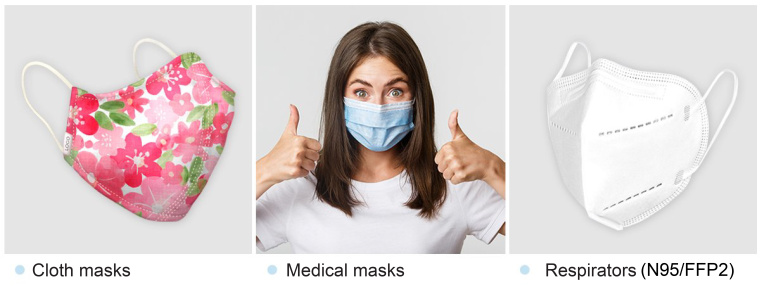In 2020 Extrapack started production of medical masks. As early as March 13, our first automated line with ultrasonic welding started operating. Since then we have gained a lot of experience and knowledge about masks and their production. We went through all stages of testing and certification. In addition to masks, we also produce the main materials from which they are made: spunbond and meltblown. We also have modern equipment with which we control their most important parameters. Extrapack is one of the few companies in Europe that has a closed process for the production of materials for masks, masks and their testing. In addition to our laboratory, we perform periodic tests in the Belgian laboratory CENTEXBEL.
Masks and respirators have been widely reported and talked about in the media lately, with sometimes contradictory statements. This article is based on our experience and the numerous scientific studies we have studied. At the end we have indicated the sources we used.
Are masks necessary in a pandemic?
Yes. Almost all scientific studies show the benefits of public use of masks. Of course, there are many conventions: what masks to use, in what situations (for example, there is hardly much benefit from using them in open spaces at a distance).
What are the main types of masks?
In general, masks are divided into three main types:
Medical masks or non-medical (fabric masks)?
Most studies show that medical masks are significantly more effective than fabric masks, such as homemade masks.
Medical masks or N95 / FFP2?
All the research we found on this topic did not find a significant difference in the effectiveness of protection between medical masks and respirators. On the one hand, the European standard FFP2 has higher requirements than the American N95, according to which these tests were performed, but on the other hand it should be noted that they are performed in hospitals where masks or respirators are provided free of charge to staff. If we have a situation in which everyone has to buy either a respirator for EUR 1.5 or a mask for EUR 0.15, it is clear that medical masks will be much more effective because they allow them to be changed more often.
What determines the quality of a mask?
The quality of a mask for civilian use depends on three main factors:
What are the standards for masks and respirators?
There are two main standards:
Respirators with a high degree of filtration, for example 99%, provide the highest degree of protection. However, these protective equipment is much more expensive than medical masks, and if people change them infrequently, it can reduce their effectiveness.
How do medical masks and respirators filter the virus?
The filtering ability of medical masks and respirators is due to a non-woven filter cloth called meltblown. Its fibers are extremely thin, but the filtration, in addition to the density of the fibers, is also due to their special electrification. They attract viruses and bacteria and they stick to them. Prolonged use, as well as attempts to disinfect masks and respirators, reduce electrification and make them ineffective. Therefore, frequent replacement of masks or respirators is recommended.
Is the respirator valve useful or harmful?
For doctors working in the intensive care unit, the valve is an advantage because it facilitates the exhalation of air. The use of valve masks in public places is rather harmful because it violates the most important protective feature of the mask - to filter the exhaled air from a potentially infected person.
https://www.cdc.gov/coronavirus/2019-ncov/more/masking-science-sars-cov2.html
Study in Germany on the effectiveness of masks as a public measure:
http://ftp.iza.org/dp13319.pdf
Systematized review of previous studies:
https://www.ncbi.nlm.nih.gov/pmc/articles/PMC7191274/
Here is a study that compares medical masks with fabric masks:
https://bmjopen.bmj.com/content/5/4/e006577
Another study comparing medical masks with those of ordinary fabrics:
https://www.researchgate.net/publication/258525804_Testin ... omemade_Masks_Would_They_Protect_in_an_Influenza_Pandemic
Research - medical masks against respirators
https://pubmed.ncbi.nlm.nih.gov/32246890/
Second study - medical masks against respirators
https://jamanetwork.com/journals/jama/fullarticle/2749214
Third study - medical masks against respirators
https://www.ncbi.nlm.nih.gov/pmc/articles/PMC7228345/
Masks and respirators have been widely reported and talked about in the media lately, with sometimes contradictory statements. This article is based on our experience and the numerous scientific studies we have studied. At the end we have indicated the sources we used.
Are masks necessary in a pandemic?
Yes. Almost all scientific studies show the benefits of public use of masks. Of course, there are many conventions: what masks to use, in what situations (for example, there is hardly much benefit from using them in open spaces at a distance).
What are the main types of masks?
In general, masks are divided into three main types:
- Respirators (sometimes called N95 after the American standard)
- Medical masks (surgical)
- Non-medical (textile) masks, including reusable masks
Medical masks or non-medical (fabric masks)?
Most studies show that medical masks are significantly more effective than fabric masks, such as homemade masks.
Medical masks or N95 / FFP2?
All the research we found on this topic did not find a significant difference in the effectiveness of protection between medical masks and respirators. On the one hand, the European standard FFP2 has higher requirements than the American N95, according to which these tests were performed, but on the other hand it should be noted that they are performed in hospitals where masks or respirators are provided free of charge to staff. If we have a situation in which everyone has to buy either a respirator for EUR 1.5 or a mask for EUR 0.15, it is clear that medical masks will be much more effective because they allow them to be changed more often.
What determines the quality of a mask?
The quality of a mask for civilian use depends on three main factors:
- Filtering ability - how much of the bacteria and viruses are retained. It is measured as a percentage of retention of particles of certain sizes
- Pressure drop - how much the mask makes it difficult to breathe.
- How well the mask adheres to the face
What are the standards for masks and respirators?
There are two main standards:
- EN 149: 2001 This is the standard for respirators used as personal protective equipment. Masks are classified according to filtration efficiency and maximum total breathing resistance. There are three classes of respiratory protective equipment: FFP1, FFP2 and FFP3. Under COVID-19, FFP2 became the most popular. An analogue of this European standard for the USA is N95, and in China KN95.
- EN 14683 This is the standard for medical / surgical masks. It also divides masks into three classes: Type I, Type II and Type IIR. In this type of masks, the most suitable for mass use are Type II.
Respirators with a high degree of filtration, for example 99%, provide the highest degree of protection. However, these protective equipment is much more expensive than medical masks, and if people change them infrequently, it can reduce their effectiveness.
How do medical masks and respirators filter the virus?
The filtering ability of medical masks and respirators is due to a non-woven filter cloth called meltblown. Its fibers are extremely thin, but the filtration, in addition to the density of the fibers, is also due to their special electrification. They attract viruses and bacteria and they stick to them. Prolonged use, as well as attempts to disinfect masks and respirators, reduce electrification and make them ineffective. Therefore, frequent replacement of masks or respirators is recommended.
Is the respirator valve useful or harmful?
For doctors working in the intensive care unit, the valve is an advantage because it facilitates the exhalation of air. The use of valve masks in public places is rather harmful because it violates the most important protective feature of the mask - to filter the exhaled air from a potentially infected person.
Appendix: Research
Summary of 45 studies from the US Department of Disaster Control and Prevention (CDC):https://www.cdc.gov/coronavirus/2019-ncov/more/masking-science-sars-cov2.html
Experimental and epidemiological data support community masking to reduce the spread of SARS-CoV-2. The prevention benefit of masking is derived from the combination of source control and personal protection for the mask wearer.
Study in Germany on the effectiveness of masks as a public measure:
http://ftp.iza.org/dp13319.pdf
We believe that the reduction in the growth rates of infections by 40% to 60% is our best
estimate of the effects of face masks.
estimate of the effects of face masks.
Systematized review of previous studies:
https://www.ncbi.nlm.nih.gov/pmc/articles/PMC7191274/
Experimental and epidemiological data support community masking to reduce the spread of SARS-CoV-2. The prevention benefit of masking is derived from the combination of source control and personal protection for the mask wearer. The relationship between source control and personal protection is likely complementary and possibly synergistic14, so that individual benefit increases with increasing community mask use.
Here is a study that compares medical masks with fabric masks:
https://bmjopen.bmj.com/content/5/4/e006577
This study is the first RCT of cloth masks, and the results caution against the use of cloth masks. This is an important finding to inform occupational health and safety. Moisture retention, reuse of cloth masks and poor filtration may result in increased risk of infection.
Another study comparing medical masks with those of ordinary fabrics:
https://www.researchgate.net/publication/258525804_Testin ... omemade_Masks_Would_They_Protect_in_an_Influenza_Pandemic
An improvised face mask should be viewed as the last possible alternative if a supply of commercial face masks is not available, irrespective of the disease against which it may
be required for protection.
be required for protection.
Research - medical masks against respirators
https://pubmed.ncbi.nlm.nih.gov/32246890/
Low certainty evidence suggests that medical masks and N95 respirators offer similar protection against viral respiratory infection including coronavirus in healthcare workers during non-aerosol-generating care. Preservation of N95 respirators for high-risk, aerosol-generating procedures in this pandemic should be considered when in short supply.
Second study - medical masks against respirators
https://jamanetwork.com/journals/jama/fullarticle/2749214
Among outpatient HCP, N95 respirators vs medical masks as worn by participants in this trial resulted in no significant difference in the incidence of laboratory-confirmed influenza.
Third study - medical masks against respirators
https://www.ncbi.nlm.nih.gov/pmc/articles/PMC7228345/
The use of N95 respirators compared with surgical masks is not associated with a lower risk of laboratory‐confirmed influenza. It suggests that N95 respirators should not be recommended for general public and nonhigh‐risk medical staff those are not in close contact with influenza patients or suspected patients.
◥✥◤










